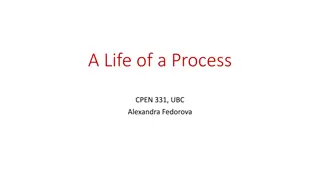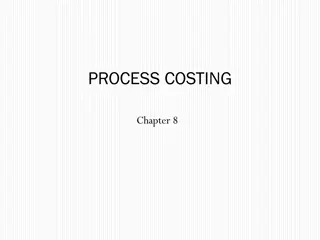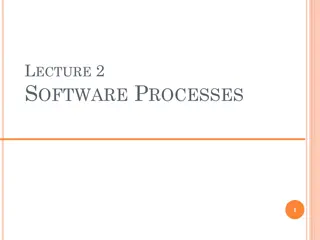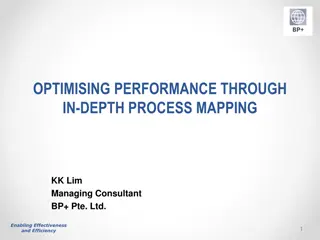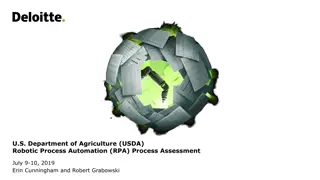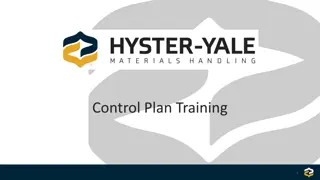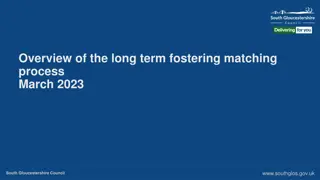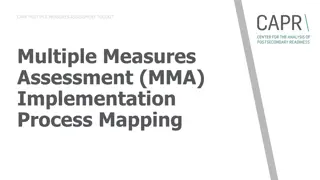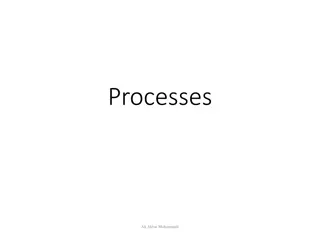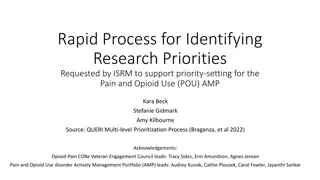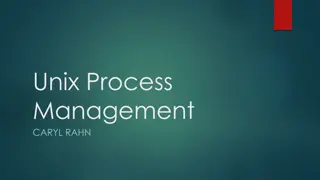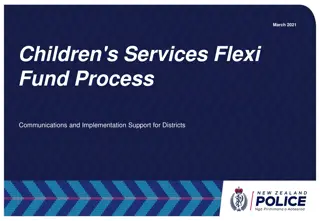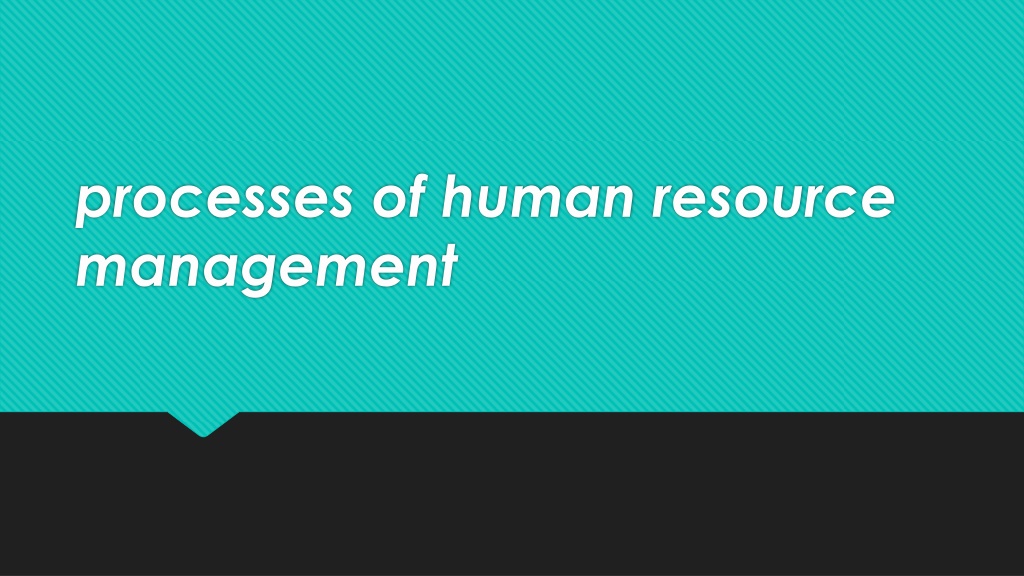
Effective Human Resource Management Strategies in the Australian Market
Learn about the vital processes of human resource management in the Australian market, including acquisition, development, maintenance, and separation. Discover the significance of recruitment in identifying and attracting potential employees with the right skills and attributes for the job. Gain insights into the evolving employment landscape and the shift towards a service-oriented economy, emphasizing the importance of employee attributes alongside skills.
Uploaded on | 0 Views
Download Presentation

Please find below an Image/Link to download the presentation.
The content on the website is provided AS IS for your information and personal use only. It may not be sold, licensed, or shared on other websites without obtaining consent from the author. Download presentation by click this link. If you encounter any issues during the download, it is possible that the publisher has removed the file from their server.
E N D
Presentation Transcript
processes of human resource management
There are 4 processes of HR acquisition development maintenance separation
The success of a business in the market place will be determined, to a great extent, by the skills of employees. This is why it is so important to identify clearly the tasks that need to be done by employees and the skills needed to do the job well. The process of acquisition is concerned with identifying staffing needs, recruiting applicants with the right skills and selecting the best candidate.
In the current Australian employment environment, recruitment is possibly the most important human resource (HR) activity. Recruitment is concerned with identifying and attracting potential employees. The purpose of recruitment is to get a good match, or fit, between the skills and attributes of the individual and the requirements needed to do the job well. Recruitment activities need to develop an applicant s interest in, and attraction to, a potential job and increase the likelihood that they will accept the job if it is offered to them.
In the past it was thought recruitment was all about getting as many qualified applicants as possible to apply for the job and then to choose the most qualified. The way to do this was to advertise in a newspaper the basic features of the job and the wage or salary. The problem with this approach is that it assumes there are large quantities of qualified applicants waiting to get a job. This is simply not the case. Australia, for most of the time, experiences full employment and, in many instances, businesses are competing with other businesses for the available potential applicants who meet their requirements.
It is also important to understand that Australia, like most developed countries, is undergoing a steady transition from an economy that focused on manufacturing to a service-orientated economy. For this reason there is a change in the type of skills businesses are looking for. Increasingly businesses are looking for employees where attributes are as important as, and more important than, skills. Attributes such as, for example, the ability to effectively relate to a wide range of people are important, particularly in businesses where the employee is dealing with customers.
The other big change that is influencing recruitment is that not only do potential applicants view jobs as good or bad, they now consider very carefully where they will do those jobs. In those jobs that require a high level of skills and qualifications, potential employees are looking for things like a happy workplace, career development, challenging and interesting work and training and development opportunities. These applicants are looking for a great place to work and this affects the recruitment process.
At the other end of the employment spectrum where applicants see jobs as lousy, with relatively poor rates of pay and often physically demanding work, the business itself is still an important consideration. If potential applicants see the business as a great place to work , the turnover rate will be less even though they consider the job itself as lousy . The turnover rate in HR refers to the length of time an employee stays in the job. If they leave relatively quickly and have to be replaced, this is referred to as a high turnover rate.
A successful recruitment process greatly depends on an effective job analysis. Job analysis is concerned with determining the skills and attributes an employee would need to do the job effectively. The information gained from the job analysis is used to create a job description. The job description or job design shows a potential applicant how the job will be done. It is important because the job description will include important criteria for a potential applicant to consider when making their decision to apply for the job. At this stage a job specification will be developed. The job specification describes the type of potential applicants who can do that job. It is, in effect, a checklist to be considered when deciding if the applicant should be rejected or considered further in the selection process.
The selection process will be more effective if the recruiting process was effective. Selection is the process of choosing the best candidate to ensure a match, or good fit, between the skills and attributes of the individual and the requirements of the job. Selection is a key element in the strategy to develop a competitive advantage and it needs to be done in a systematic way.
The selection process is concerned with identifying people with the skills and attributes to perform a job really well before those people have done the job. Selection is concerned with predicting which of the applicants will do the job best. And it is very important to get it right, because - while the right candidate can contribute to business goals - a poor choice can result in dysfunctional behaviour, such as conflict with managers, stealing and sometimes sabotage. The selection process is also very costly and has legal implications in relation to things like anti- discrimination and equal opportunity legislation.
There are several methods businesses typically use to select candidates. The most common are interviews and work simulations. Whichever method is used it is important to ensure that it is reliable, valid and cost-effective. The reliability of the selection method refers to its accuracy and consistency.
The most commonly used method of selection is the interview. An employment interview uses oral responses to oral questions as a way of predicting future job performance. Typical questions include: * What is your previous work experience? * What do you think you have to offer our business? * What qualities should a successful manager have? * What are your interests?
There is considerable disagreement on the reliability of interviews as a method of selection. A number of studies indicate that the interview has relatively low reliability compared to the work simulation method. Work simulation is where the candidate demonstrates their skills and attributes with a typical aspect of the job, in front of the assessor, or person doing the selection process. If the job requires certain key skills, the ability to weld, for example, it is possible to assess the applicant with a high level of reliability.
The selection process for jobs, such as retailing or service, often uses a personality test. The candidate completes a personality test and this is then compared with a profile demonstrating the ideal attributes needed to do this job well. The candidate closest to the ideal is chosen. Often, this approach is linked to behavioural questions such as: what would you do if this particular circumstance occurred? The reliability of work simulation and personality testing is quite high.
Validity is another important criterion that needs to be considered regardless of which selection method is used. Validity is concerned with the degree to which a method actually selects the work behaviours in the job specification. For example, compassion is important work behaviour in an aged care home. The method used to select a candidate would not be valid if it failed to assess the candidate s compassion.
Validity is improved in the interview method if the interview is conducted in a highly structured manner so that all the implications in the job specification are carefully considered. Legal requirements also impact on the validity of the method used to select the candidate. There is, for example, important legislation dealing with things like ant-discrimination, disability, women and migrants that could affect the validity. Again, a structured approach to the interview is more likely to effectively deal with these issues and improve the validity.
The cost-effectiveness of the selection method needs to be carefully considered. Ideally applicants would perform the work activities required for a day or two and the HR assessors making the selection would observe the applicants performance and formally assess it. But this would generally be too expensive. Each applicant would need to be paid, there would be a great deal of disruption, the applicants might well resent this approach and it would take a great deal of HR time. On the other hand, a quick chat over coffee is unlikely to be a reliable and valid method of selection, although it would be a low-cost method. The actual method chosen to select an applicant will be a balance between reliability, validity and cost-effectiveness.
The final aspect of the selection process is concerned with background checks and reference checks. Some people lie. You might be aware of a recent nasty situation at a Queensland country hospital where a senior surgeon was employed to do operations for which he was not qualified. A number of patients were, as a consequence, harmed. Simple checks with previous employers and checks on the qualifications he claimed he had would have made it obvious that he was not qualified for the job. This poor example of selection cost the hospital a great deal of money and affected its reputation.
Typically, checks are made to verify the accuracy of the applicant s statements as well as criminal checks to ensure the applicant has no history of crimes like theft. Even references need to be carefully considered. Sometimes a previous employer might give an applicant a good reference simply to get rid of them. Sometimes the previous employer might be frightened of legal action if an accurate assessment of the employee s record is given.
Development Development is important to both the business and the individual employee. Development is concerned with improving employee skills and knowledge. An effective development program will raise employee skill levels and in this way improve the productivity of employees.
Productivity is an important aspect. Productivity is an increase in outputs using the same inputs in a given period of time. For example two employees might stack 300 boxes in a day. If given a forklift and trained in its use, they may stack 1 000 boxes a day. The productivity increase is 700 boxes. In the short term it will be expensive to lease the forklift and train the employees in its use. In the long term costs will be reduced and profitability will increase.
Development is also important for the individual employee. Increased knowledge and skills can lead to higher paid work and reduce the prospect of unemployment for that worker. For example, stacking boxes is a low-skilled job that may well be not available if economic conditions change. However, a forklift job is more available.
The most immediate aspect of development is induction. Induction is the training given to new employees to enable them to do the job effectively. Effective induction programs focus not only on the initial job skills (ensuring a cash register operator, for example, is familiar with the specific machine being used) but also help the new employee to understand the business culture.
Culture refers to the attitudes and values (how things are done here ) in the business, and it is very important. Another aspect of induction is an effective program to help the employee settle into the social aspects of a new workplace - that is, get to know other employees, find out where the canteen and toilets are, and so on.
Socialisation is something that needs to be carefully considered in an effective induction program. At the bottom level of skills where the job is low paid, often physically demanding and not very challenging, it is still important that the employee regards the employment in terms of: This might be a lousy job but this is the best place to do it. At the top end of the skill scale it is important to build a long-term relationship with core employees because, when there is a skill shortage, these are the employees who must be retained.
Socialisation is about fitting in and feeling a sense of belonging. There is a number of strategies that can be used but they need to start right from the first day at work, where new employees are effectively introduced to colleagues and team members and are accepted into the social networks.
When it comes to doing the actual job, an effective training program is required. A training program refers to the systematic way knowledge and skills will be taught to the employee. A typical training program includes:
Needs analysis Needs analysis is concerned with identifying the knowledge and skills the employee will need to have in order to do the job effectively.
Instructional design Instructional design is concerned with setting the objectives for the training program (what things will the employee have to know and what skills will they need to have), working out how that knowledge and skills will be taught and how the effectiveness of the program will be assessed (how will you know if the employees have learned the information and developed the skills). Of course this program will cost money and a budget should also be developed to show how much it will cost and when the money will be needed.
Implementation Implementation is concerned with the strategies that will be used to actually teach the required knowledge and skills to employees. Typically, these strategies include things like on- the-job training, on-line instruction, instructional video and mentoring.
Evaluation Evaluation is concerned with finding out if the training program was successful, in the sense that the employee gained the required knowledge and developed the required skills.
There are also several reasons that a business benefits from an effective development program. These include:
1. Training improves the flexibility of a business by ensuring employees cannot only carry out the required tasks efficiently and in a cost-effective manner but also monitor the quality of the work they do and develop multi-skills in a range of business activities. For example, before the production facility was relocated to China, the Seven Hills factory of textile manufacturer, Pacific Brands, was remarkably flexible, in the sense that the production facility could quickly adapt for the production of a particular garment anywhere from a run of 500 to 50 000. The employees were multi-skilled and every employee could operate every machine in the factory and do every job, while monitoring their own quality and effectively operating in teams.
2. An effective development program prepares employees for future jobs in the business. This is one of the most important strategies in developing long- term relationships with the employee. The business works with the employee to establish a career path and identifies the skills and knowledge that will be required for the next promotion. Often the employee will voluntarily contribute to the development program by taking courses outside the business that prepare them for the promotional position. At the higher skill levels, mentoring is a key aspect of this sort of program. Mentoring is where the employee currently in the promotions position works with another employee to show them what they are doing and preparing them to take over that job.
3. An effective development program can protect a business from skills shortages. This is currently an important consideration in the Australian economy. In the mining industry, in particular, many businesses are struggling to get employees with the skill levels they require.
4. An effective training program makes it much easier for a business to adapt to changes in the external environment. It is difficult to effectively introduce new products or change work practices without training and a business culture where employees embrace change. Without exception Australia s largest businesses, such as Orica Limited, have extensive training programs designed to not only teach employees the skills they need but also develop a culture of change.
When businesses compete with other businesses on the basis of quality products, such as retail businesses like Big W and Kmart or businesses in the hospitality industry like hotels or restaurants, it is essential to have a highly committed workforce where there is a great deal of employee involvement, where employees work in self-managing teams and rewards are merit- based. Developing the employees in businesses like these is the main way the business develops its competitive advantage.
Development programs have short-term and long-term implications for a business. In the short- term the improvements in productivity and quality affect liquidity. Liquidity is something we will look at in detail in the next topic, but it refers to the ability of a business to pay short-term debts. Training programs are very expensive and impact on the cash reserves of a business at the time they are developed and implemented. The long-term implications are lower costs, better quality, higher revenues and improved profitability and market share. The problem is that some management teams think short-term.
Maintenance We have tried to show that there are often two approaches to human resource management. One approach is to focus on the short term and the other is to focus on the long term. The short- term approach accepts there may be high turnover levels. Some hotels, for example, rely on backpackers for the low-paid, physically demanding jobs such as cleaning. Employee turnover is high but expenses are minimised in the short term.
Other hotels adopt a long-term strategy based on employing locals and developing a workplace environment where room cleaners may well see the job as lousy but feel this is the best hotel in which to do this lousy job . The hotel is able to develop a long-term relationship with the employee. Maintenance is concerned with building a long-term relationship with employees using strategies such as reward management, performance appraisal, employee participation and concern for issues such as occupational health and safety, work-life balance and workplace bullying.
Reward management is a core element of a maintenance program. Reward management refers to the monetary and non-monetary benefits employees receive for their work. Of course this is the main reason people go to work. If a business is to attract and retain the people with the skills it requires, then the wages and salaries it offers need to be competitive.
However, people want more than just the monetary reward. Good employees also want recognition of the fact that their work is good. A failure to provide that recognition might mean they go to a competing business that has a reputation as a good place to work.
Occupational health and safety is a crucial part of an effective maintenance program. Employees are entitled to a safe workplace and large Australian businesses ensure the workplace is safe. Occupational health and safety also involves ensuring the workplace is free of harassment and discrimination.
Performance appraisal is an essential element of an employee maintenance program. Performance appraisal provides feedback to both the employee and the supervisor as to how well the employee has done the job. Good employees want this sort of feedback. It acknowledges that they have done the job well and establishes further challenges. Knowing what they have to do to improve their work also benefits employees who have been assessed as doing the job poorly.
Separation In the past, separation was quite simple. Employees tended to stay with a business until they retired or were dismissed or possibly left to get another job. It is more complex today. Separation is the process where an employee leaves a business, either voluntarily or involuntarily, and it needs to be carefully managed. Voluntary separation requires that the employees receive all relevant entitlements such as, for example, payment for any long- service entitlement that has not been taken.


